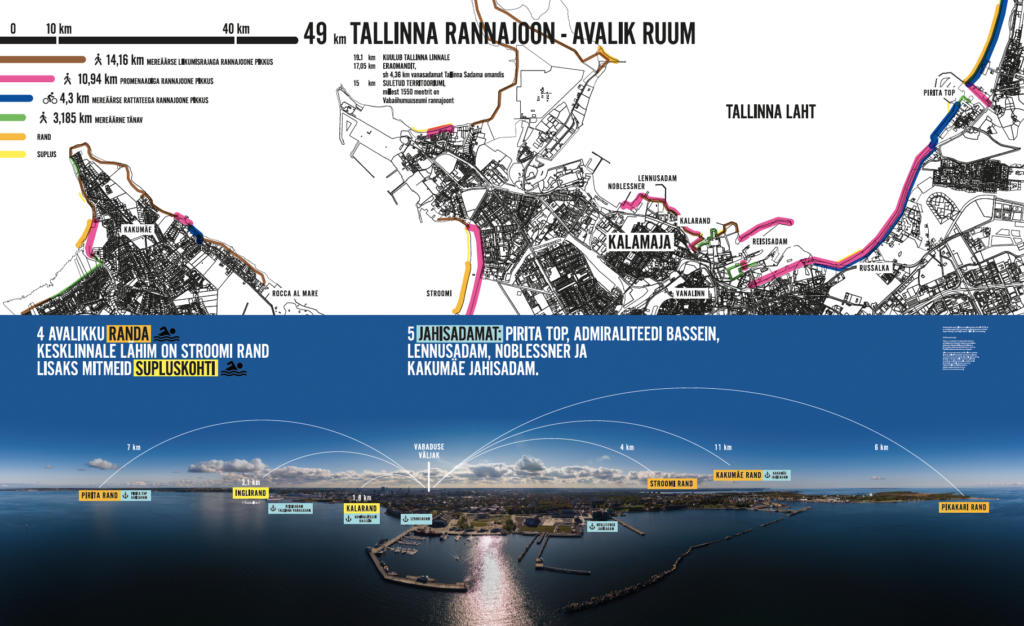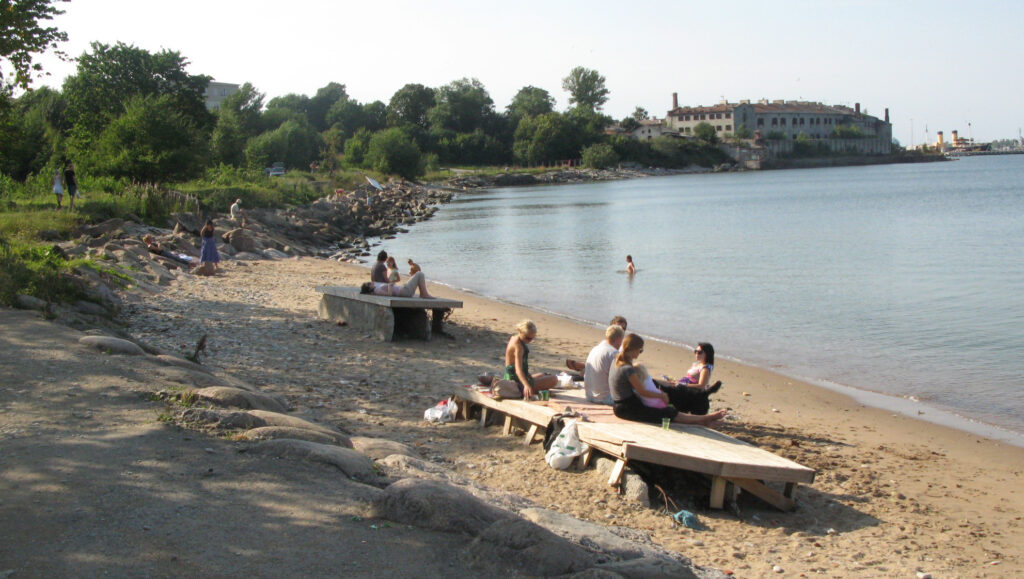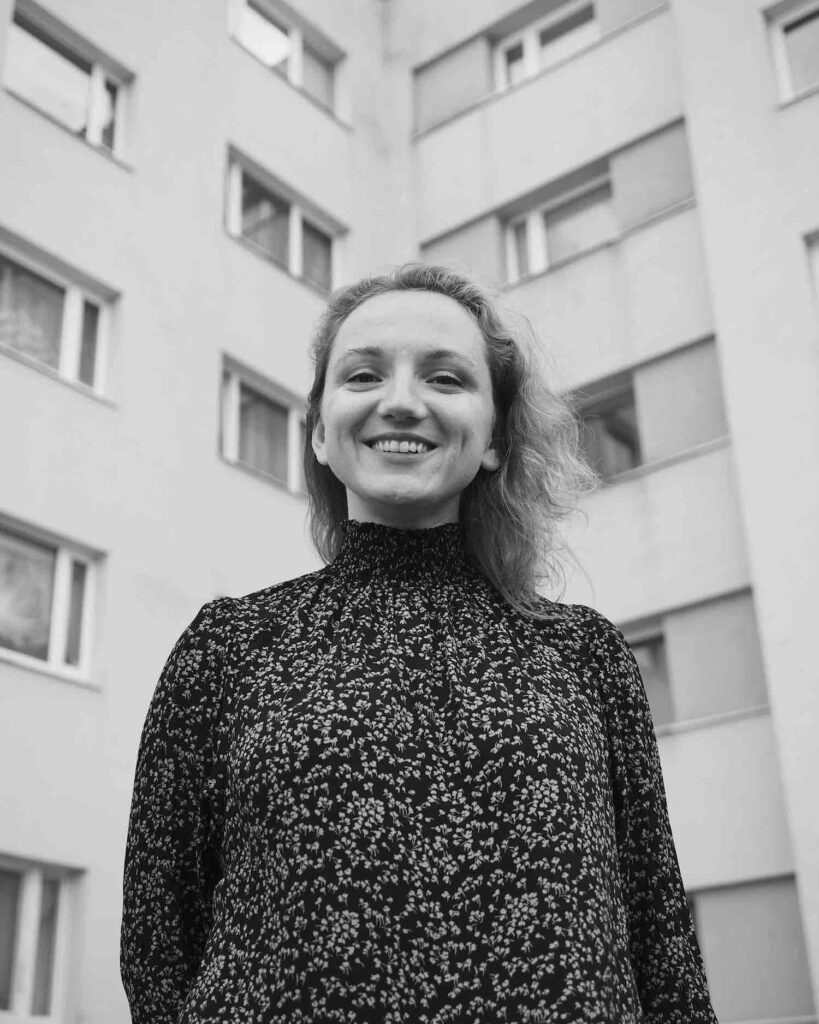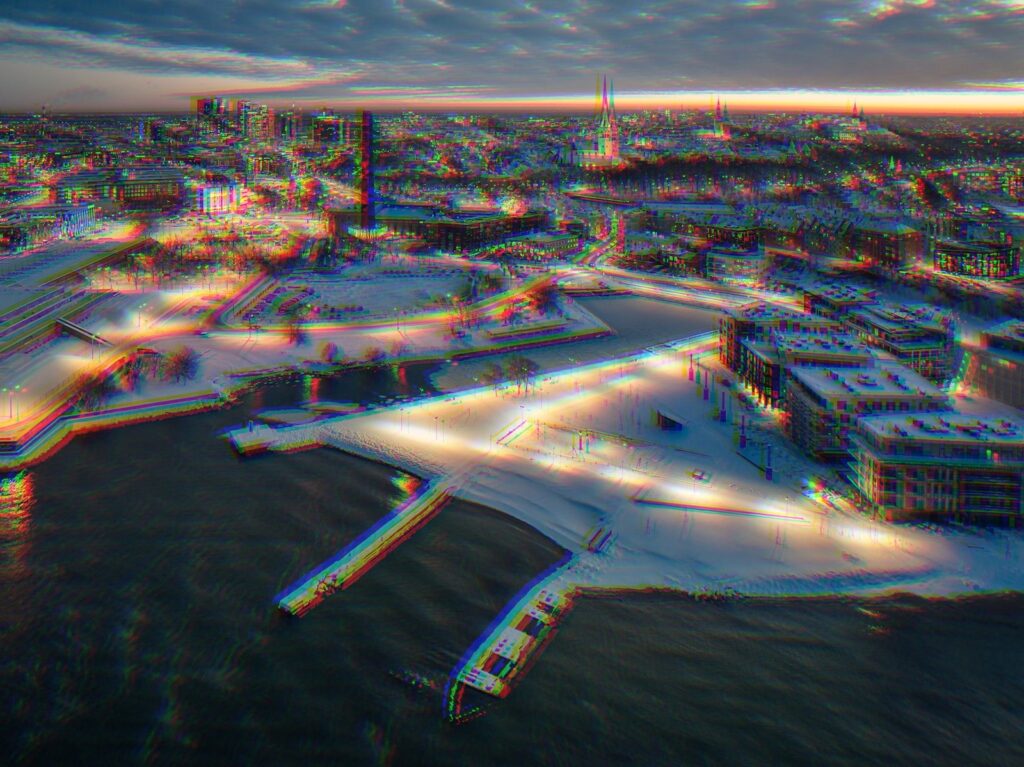The genesis of Kalarand is a search for novel urban ideals. Amidst arduous planning and controversy, a number of urban activists matured and professionalised. In a prototyping-like process, several expectations we consider fundamental today on the subject matter of public space and spatial justice were made visible, and solidified. Johanna Holvandus writes on the changes in urban activism and urban processes.
The author would like to thank Maroš Krivý for an interesting conversation that inspired this commentary.
For the past 20 years, Kalamaja neighbourhood, especially the waterfront, has been a hot spot for urban and real-estate development. As it often is, intense and seemingly uncoordinated developments cause a stir and reaction among many, but in particular with local residents. As such, Kalarand development may very well be the focal point for one of the most controversial and heated debates between the municipality, real estate developers, and activists in modern Tallinn, illustrating the clashes of socialist era institutional remnants and often unattainable ideas of social justice through neoliberal city planning.
Maroš Krivý and I sat down to think and discuss how the socio-spatial fabric in the gentrifying Põhja-Tallinn district has changed and is still changing, what the outcomes in terms of activism, socio-spatial justice, policy and governance networks have been, and what the future urban perspectives here in Kalamaja but also in Tallinn in general may be. Although our dialogue set off as a commentary on the development of modern Kalarand, more universal topics of discussion emerged on the backdrop.
What was, what is, and what will never be again?
If we look at Kalarand or Kalamaja in general as it was in the early 2000s, the area was just starting to gain notice with its shabby wooden housing and derelict empty spaces, the remnants of industries that had been but were no more. Kalamaja was no longer seen only as an area of deprivation or oblivion, rather the neighbourhood started to offer new possibilities and rediscovery of what could and should be. The somewhat unconscious search for nostalgia and shabby chic led to the hipsterville we see and consume daily today. But back then, at the beginning of the millennium, it was more about these forgotten and closed spaces waiting to be opened and rediscovered. The Kalarand public beach, the Cultural kilometre, and the Beta promenade are the three main pop-up or temporary natured interventions which come to mind that aimed to re-open the coastline, which had been closed to the public for decades. This narrative of Tallinn being a seaside city whose seaside is basically still inaccessible has been a thorn for many urban professionals and activists not only with the Kalarand development, but also, for example, with Reidi Road or even Pirita Top. However, as it often is with temporary urban solutions, they grow into something more permanent by staying in our consciousness and thus affecting the course of urban development. And so, when the long-term proposals were finally greenlighted for Kalarand and it became clear that the essence of these developments contradicted the nature of temporary solutions among other things, a strong reaction among the locals occurred.

But the debate or narrative of ‘to whom this urban space is opened’ runs deeper than merely just ‘to and for the public’. If we look closer at the physical as well as social developments in Põhja-Tallinn, there are undeniable implications of displacement and exclusion. Who were the local residents 20 years ago and who are they now? Põhja-Tallinn which even ten years ago used to be ethnically and socially the most diverse district in Tallinn shows more and more signs of becoming homogeneous—providing certain je ne sais quoi which is becoming more and more attainable to less and less users. Telliskivi Creative City which has been a cultural hub and trend setter since its fruition has simultaneously been the engine behind very particular consumerism which as a rule excludes the majority of the permanent locals.1 Or the more recent Noblessner development whose clientele—so to speak—is by all means young, trendy and well off, not at all the retired Russian auto mechanic with an auto shop in Kopli and who used to live in the Sitsi barracks.
So yes, we’ve come a long way from these empty abandoned spaces ripe of possibilities and discovery and we are often given town squares full of trendy cafes, breweries and designer shops and apartment blocks by the seaside with views of the sunset overlooking someone else’s window. In one of the most segregated cities in Europe that has already for years been facing the challenge of providing enough affordable housing, it is urgent to ask to and for whom exactly are we creating these spaces and snugly placed apartment houses. Who is invited to this neighbourhood, who is unwelcome, and where do the unwelcomed ones end up going to?
The political urbanism game
But the question here, of course, is more about the underlying vision of Tallinn and its urban ambitions and development. What are the values we wish to keep and attain? The more heated debates surrounding Tallinn urban trajectory and vision emerged in the mid-2000s when inner city areas as well as the waterfronts fell under strong real estate development interest and activity. This led to the mushrooming of neighbourhood activism which was often ignited with strong reaction against certain developments and shared NIMBYism-like points of view. Rather quickly these associations tried to turn to a more proactive rhetoric aiming to contribute a different point of view to quite a cemented and outdated two-way discussion between the municipality and the private developers.2
For a while the map of activism seemed relatively unvaried and uniform—the neighbourhood associations were without a doubt the most visible actors on the activism landscape arguing for spatial justice and a more diverse and inclusive urban environment. This might have been a direct result of the know-how of the activists, since many of them had some expertise in the urban field and possessed what could be referred to as a ‘cool aesthetic of activism’—young professionals in their 30s with certain social stature engaged in bettering the urban vision of Tallinn (this form of activism could be also referred to as a form of conspicuous politics.3 It seems quite paradoxical that neighbourhood activism as it emerged entailed similar connotations of polarity as did the environment they were trying to preserve. On the one hand, the activists themselves had chosen the living environment based on the characteristics that were present and were now engaged in maintaining the status quo. On the other hand, they themselves could be considered the drivers of urban change and commodifying the environment they were trying to preserve. As with discovering empty spaces, mapping different types of activism led to the question concerning other types of activism besides the above-mentioned, whose activity has always been directly targeted on issues of social justice, e.g., the well-being or opportunities of ethnically and socio-economically weaker groups, but have not been as visible on the activism spectrum as they are today.

It is clear that the map of activism is changing and has become more fragmented. The heyday of neighbourhood-particular activism seems to be over since neighbourhood-specific social gatherings are not a primary channel for spreading the message or engaging the locals. It is but a natural occurrence since being active requires motivation and resources, and both tend to run out at some point. Instead, it appears we can highlight more specific communities that have no neighbourhood or city district boundaries, for example, activism for walkable/cyclable cities or call for a greener living environment. Furthermore, activism in some measure seems to have moved from real-life to virtual life. Although social platforms were always a tool to get a message across, they have become much more crucial now after society has had to adapt during a global crisis.
One of the most visible platforms today is definitely mitte_tallinn—entirely and only active on social media. In addition, although the activists often declare themselves to be apolitical, at certain points it becomes clear that being active is a very political game—forming networks, taking a stand, opposing the status quo or by just sharing a point of view. There are examples of activists who past this certain point have officially moved to the political arena.
Still fending Tallinn from the Ülemiste elder
From the urban development perspective, Tallinn is a difficult case because of the ultra-fractured ownership structure that sets limitations on forming a comprehensive and balanced urban vision. The municipality seems to have played itself into a corner a long time ago and the struggle to balance the socio-urban needs with what the (real-estate) developments actually offer is still strong. The reasons for that are different. First, in a post-socialist city, unfortunately, the left policy is often completely discredited in fear of being associated with past regime. Tallinn’s experience shows that in the 1990s neoliberal ideas were taken over without much hesitation, paving the way for cowboy capitalism that eventually saw its demise in the late 2000s. However, the results of these decisions made back then are only becoming visible today, starting from a lack of affordable housing to dissatisfaction with mobility options within the city. Second, modern urban debates are no longer fixed on social justice issues only but have grown into socio-environmental justice issues. In this sense Tallinn still gives out mixed messages. On the one hand, Tallinn presents itself as a green capital attentive to environmental issues and initiatives such as the newly developed Putukaväil (Pollinator Highway). On the other hand, however, we are witnesses to inefficient and short-sighted initiatives such as the red bicycle tracks which positive environmental impact is doubtful to say the least. But even with sustainability interventions such as Putukaväil which aim is biodiversity protection, the municipality should be very aware of the potential consequences accompanying green gentrification that might lead the neighbourhood to becoming more exclusive.

Circling back to the impact of the Kalarand development on Tallinn’s urban vision, I believe there are two-three key takeaways. First, it is clear that the urban processes set off 20+ years ago in Põhja-Tallinn have led to the understanding among many that the ultra-neoliberal model for Tallinn city planning needs to be rethought. The society and its needs have changed and so should the urban environment that is created, focusing much more on environmental issues, socio-spatial justice, and diversity.
Second, inarguably the Kalarand development as a case study has facilitated the birth and evolution of a generation of urban activists. This wave may have started as a reaction against something but has resulted in a generation of citizens more aware of their abilities and rights of how to actually be part of the urban development process and learn how to help it grow.
And third, urban change happens constantly, it is circular and tends to have hot spots. The key as with all market situations is to find balance of how to maintain the diversity, create a framework for acknowledging different types of activism, cool down or ignite the development when needed, and above else have a strong and universal understanding of where Tallinn’s urban trajectory should be headed and stand firmly behind it.

JOHANNA HOLVANDUS is a human geographer and board member of Linnalabor (Urban Lab). Her research focused mainly on the genesis of various types of collaboration networks in urban politics and planning. She is currently employed as an analyst in the IT-sector while continuing her passion for spatial matters.
HEADER: view of Kalaranna Quarter. Photo: Kaupo Kalda, photo editing: Gella Alver
PUBLISHED: Maja 108 (spring 2022) with main topic Opening Tallinn to the Sea
1 Ingmar Pastak, „Gentrification and displacement of long-term residents in post-industrial neighbourhoods of Tallinn“, https://dspace.ut.ee/handle/10062/71881.
2 Keiti Kljavin, Johanna Holvandus, Kaija-Luisa Kurik, Ingmar Pastak, „Aktivism avaliku ruumi koosloomes“ [transl. ‘Urban activism in the co-creation of public space’], https://inimareng.ee/aktivism-avaliku-ruumi-koosloomes.html.
3 Piret Tõnurist, Rainer Kattel, Veiko Lember, „New Leisure Class and Conspicuous Politics in Urban Regeneration Initiatives“, 2015, https://www.researchgate.net/publication/283504293_New_Leisure_Class_and_Conspicuous_Politics_in_Urban_Regeneration_Initiatives.





